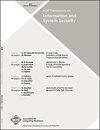LOT:防御IP欺骗和泛洪攻击
Q Engineering
ACM Transactions on Information and System Security
Pub Date : 2012-07-01
DOI:10.1145/2240276.2240277
引用次数: 31
摘要
我们提出LOT,一种部署在网络网关的轻量级即插即用安全隧道协议。两个通信网关A和B运行LOT,可以自动检测对方并建立有效的隧道,保证通信安全。LOT隧道允许A丢弃在B的网络中指定源地址的欺骗数据包,反之亦然。这有助于减轻许多攻击,包括DNS中毒、网络扫描和最明显的(分布式)拒绝服务(DoS)。LOT隧道提供了几种针对DoS攻击的额外防御。具体来说,由于从受LOT保护的网络接收的数据包不能被欺骗,因此LOT网关实现配额,识别和阻止来自特定网络的包洪。此外,接收LOT网关(例如,B)可以将分配给每个隧道的配额发送给对等网关(a),然后对等网关(a)可以执行近源配额,通过在流量离开源网络之前过滤过多的流量来减少浪费和拥塞。同样,LOT隧道也支持近源过滤,即发送网关根据目的网关定义的过滤规则丢弃报文。LOT网关还实现了网关间拥塞检测机制,允许发送网关在到达目的网关之前检测其数据包何时被丢弃,并执行适当的近源过滤以阻止拥塞流量;这有助于防止对连接两个网关的骨干网络的DoS攻击。LOT是实用的:它易于管理(即插即用,不需要网关之间的协调),在边缘网关上增量部署(而不是在主机和核心路由器上),并且在带宽和处理方面的开销可以忽略不计,正如我们实验验证的那样。LOT存储要求也不高。本文章由计算机程序翻译,如有差异,请以英文原文为准。
LOT: A Defense Against IP Spoofing and Flooding Attacks
We present LOT, a lightweight plug and play secure tunneling protocol deployed at network gateways. Two communicating gateways, A and B, running LOT would automatically detect each other and establish an efficient tunnel, securing communication between them. LOT tunnels allow A to discard spoofed packets that specify source addresses in B’s network and vice versa. This helps to mitigate many attacks, including DNS poisoning, network scans, and most notably (Distributed) Denial of Service (DoS).
LOT tunnels provide several additional defenses against DoS attacks. Specifically, since packets received from LOT-protected networks cannot be spoofed, LOT gateways implement quotas, identifying and blocking packet floods from specific networks. Furthermore, a receiving LOT gateway (e.g., B) can send the quota assigned to each tunnel to the peer gateway (A), which can then enforce near-source quotas, reducing waste and congestion by filtering excessive traffic before it leaves the source network. Similarly, LOT tunnels facilitate near-source filtering, where the sending gateway discards packets based on filtering rules defined by the destination gateway. LOT gateways also implement an intergateway congestion detection mechanism, allowing sending gateways to detect when their packets get dropped before reaching the destination gateway and to perform appropriate near-source filtering to block the congesting traffic; this helps against DoS attacks on the backbone connecting the two gateways.
LOT is practical: it is easy to manage (plug and play, requires no coordination between gateways), deployed incrementally at edge gateways (not at hosts and core routers), and has negligible overhead in terms of bandwidth and processing, as we validate experimentally. LOT storage requirements are also modest.
求助全文
通过发布文献求助,成功后即可免费获取论文全文。
去求助
来源期刊

ACM Transactions on Information and System Security
工程技术-计算机:信息系统
CiteScore
4.50
自引率
0.00%
发文量
0
审稿时长
3.3 months
期刊介绍:
ISSEC is a scholarly, scientific journal that publishes original research papers in all areas of information and system security, including technologies, systems, applications, and policies.
 求助内容:
求助内容: 应助结果提醒方式:
应助结果提醒方式:


